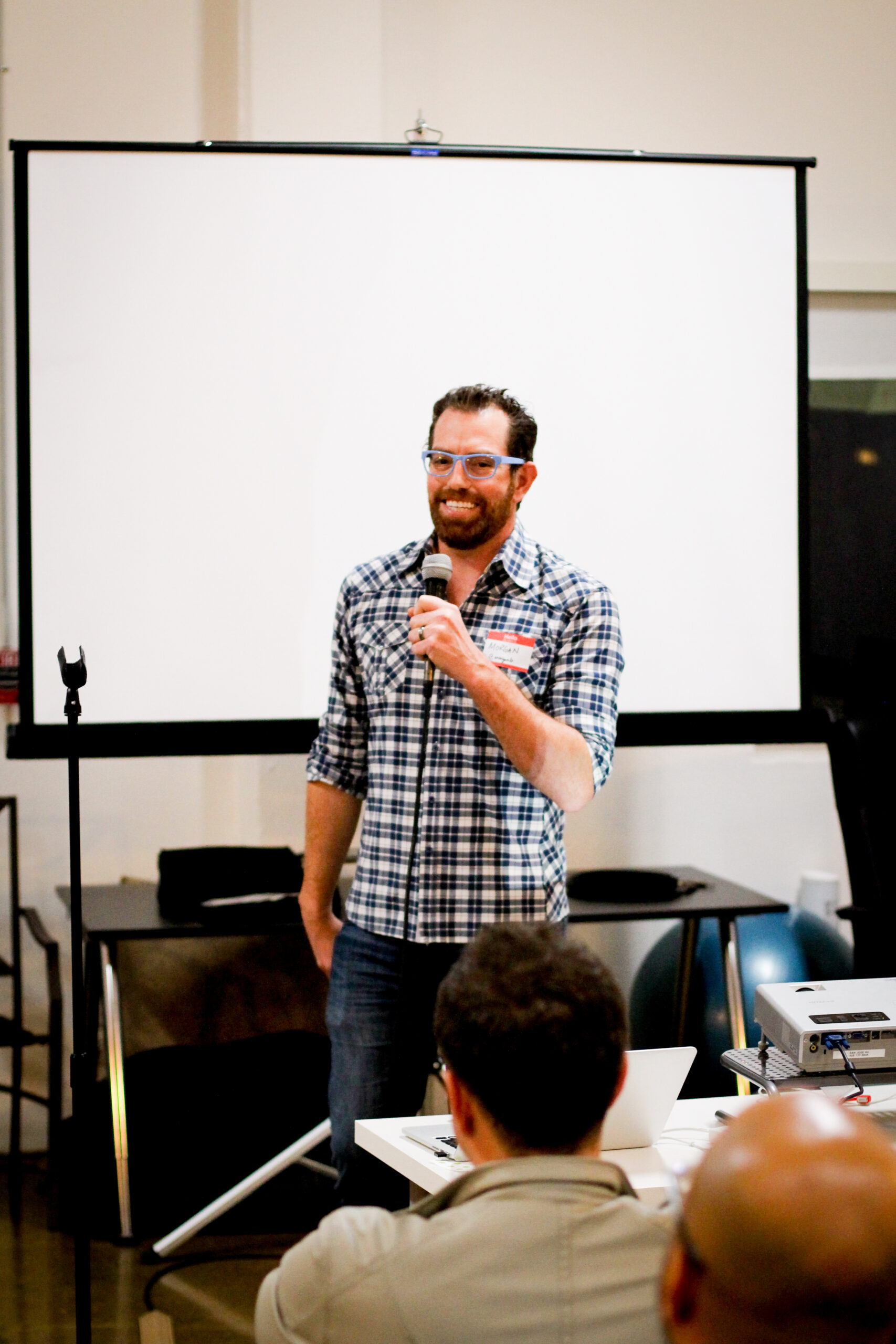This short piece covers a talk on Mobile Growth given by Morgan Brown at a recent Branch & Declara sponsored Dev Meet Up. Read more and watch the full talk below!
The baby blue glasses you see in his headshot are in fact very real. As is his exuberant smile, and scruffy, but gregarious look. In his opening remarks with Branch at Declara, Morgan Brown put on a pony costume in an attempt to make sure that, if nothing else, the crowd left the night with a good memory. But throughout his talk, it wasn’t his glasses, hilarious references, or his pony costume that galvanized the crowd. The most lasting impressions that Morgan left on the audience came from an hour long deep dive into the most important lessons on growth at nascent companies.
In the technology industry, a hyper-competitive space, where more than 45,000 apps are created per month, and where most startups face a less than 1% success rate, growth is the name of the game. In fact, in one McKinsey study Morgan mentioned, companies with higher growth resulted in 5 fives higher returns over a long-term horizon. Growing, and doing it fast, and right, is winning.
So what were some of Morgan’s major insights? What’s the right way to grow? Mobile Growth with Morgan Brown from Branch Metrics on Vimeo. You can find the slides Morgan went through here.
A Simple Startup Equation: G = f(Product-Market Fit)
First, your growth engine is very much a function of product-market fit — companies need to embrace this, not resist it. As Morgan describes, product market fit is really a continuum determined by churn and retention. It also determines your upside opportunity. If you don’t have a great product and a ripe enough market, then you’ll be pushing the metaphorical rock of your company’s success uphill foerver. More importantly, most companies make the mistake of trying to grow before they have product-market fit. Or as Morgan put it, “Growth without product-market fit won’t be successful.”
A new-age example of miscalculated product-market fit and hypergrowth gone awry is Clinkle. After raising $25 million in funding, Clinkle started a campaign to hyper grow over the summer of 2013. However, without a stellar product (or in this case ANY product), and without a good market fit — the market was already crushed by Venmo and Paypal — Clinkle’s growth engine was not off to a great start. It’s the reason why the company had to go through multiple rounds of layoffs, which only certainly made things hard at home.
Growth as a Process
In a classic throwdown to everything that Stanford’s D.School preaches, Morgan also emphasized the notion that growth is an iterative idea-centric process . It must be a systematic approach to discovering and capturing users, and cannot be haphazard. Morgan suggested testing lots of different experiments (thousands in fact) in an attempt to capture the best way to reach your users. Test what works and test what doesn’t. Look at your user activities and get feedback on your product from the people using it.

What’s most important, however, is that ideas are the currency of growth. The more ideas you have and are testing, the better you will be able to succeed. In a reference to another Head of Growth at a local startup, Morgan mentioned that his friend ran 8 months of over 1000 growth experiments. As a Growth lead, he employed 6 full-time people to think of, develop, test, and document growth experiments. This might sound crazy, but pushing to develop this level of testing is what growth is really all about. Testing ideas is the fuel for this growth as a process and allows you to better discover the ways you should be reaching your users.
At the Best Companies, Everyone is on Board
Once you’ve conducted an insane amount of testing, there is a particular protocol to follow to make sure your experiments aren’t wasted. If ideas are the currency of growth then most startups will be loading up on currency and running hundreds (or thousands) of tests to understand their user. Don’t let this process stop with the marketing team. Make sure to share ideas across your organization — engineering, business development, sales; everyone should know. In fact, at the best companies, everyone not only knows about the insights from growth ideation — everyone is also on board.
Once you get ideas to spread across your organization you can drive new insights into all the different ways you approach your users. The different branches of your company will undoubtably be able to tailor they way they serve the customer, market the customer, sell to the customer, and much more.
 Afterwards, developers and growth hackers got a chance to dive deeper into growth developing.
Afterwards, developers and growth hackers got a chance to dive deeper into growth developing.Test & Optimize
In a similar cue to ideation and sharing insights across the organization, Morgan also underscored the importance of optimization. Sharing insights isn’t enough if your company’s different teams aren’t translating insight into action. Optimization of the product and process is the key to success. This is where internal testing is so important. Most startups, surprisingly, are underinvested in metrics — not only about their product features, but how they are selling, marketing, and growing. The best thing you can do for your ability to grow is to capture the right metrics from the start. It sounds cliche, but you can’t manage what you can’t measure. Don’t wait for the realization of mismanagement to set in. Develop systems from the start that allow you to capture the right data about your user.
Fundamentally, this means investing in metrics and product instrumentation up front, so that your team can learn from growth experiments. A great example of a company that has this well is Soundcloud, where their mobile growth stack is filled with people who know the underlying metrics that drive growth and have incredible expertise.
It’s all about Feedback
It’s really as simple as it sounds. Great growth teams need to look to their users’ activities to understand how to drive further growth. This is where feedback is so important. Finding good feedback can come from a number of channels — the app store, in-store feedback mechanisms, or even randomized survey data. However, never underestimate the power of app store reviews. In fact, as Morgan mentions, positive reviews are essential to having your app seen.
Similarly, having negative reviews can totally destroy your app’s chances of success. Negative reviews often come about from nagging your users or from embedding feedback requests in the UI as a pop-up. This is an easy way to turn users off of your app, to decrease installs and conversions, and to ruin your app’s rating.
If you’re in the situation where historical app reviews are a problem, there is still hope. As App In the Air did, you can turn around negative reviews around by finding the users who wrote bad reviews, acknowledge their issue or complaint, fix the problem (whether it’s a feature, experience, or otherwise), delight them, and ask for them to modify their review. In most cases, they will be impressed to hear from the developers and if the problem gets fixed they would be happy to change it.
Double Down
In his final moments, Morgan offered what was probably the most salient point on mobile growth development. Most companies, he noted, don’t get many growth channels working, they get one channel working. Beyond this, they take for granted what they are doing well! Really, the key to mobile growth success is focusing more attention on what you’re doing well at. As Morgan advised, spend less resources on trying to find something new.
Double down on what’s working.

Doubling down on what’s working isn’t easy, but Branch can help you identify your best organic growth channels. After the meetup, Branch and community members talked about growth in nascent companies.
Final Tips?
In the final moments of closing, Morgan shared some great bite-sized takeaways for companies looking to grow:
1.) When thinking about referral or reward programs, give away value before you give away money.
2.) The best apps drive off of word of mouth.
3.) You should always be thinking about App Store Optimization — and don’t hire anyone but an expert. If you don’t have the time or capital to do so, then check out mobileaction.co and this quick cheat sheet from Word Data.
For an even deeper dive, you can find all the slides Morgan went through here .
About the Speaker:
Morgan Brown is a growth and marketing executive that works with early stage startups to gain traction and help reach major growth milestones in terms of user acquisition, retention and revenue. He currently serves as Head of Growth at TrueVault and Qualaroo. In the past he has served in growth and marketing roles across a diverse portfolio of companies.






















